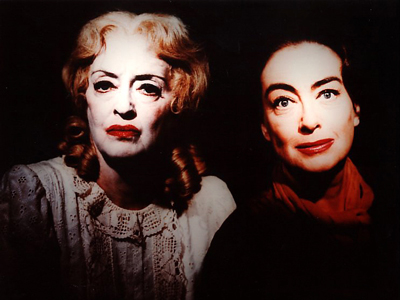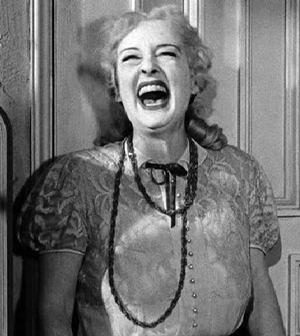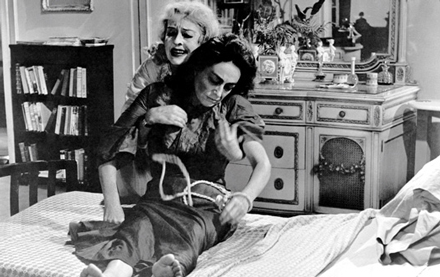
 |
|
|
|
Now remembered as a Camp classic for the enjoyment of 'fans' of the famed career-long blood feud between actresses Bette Davis and Joan Crawford, What Ever Happened to Baby Jane? is actually an innovative horror film in the tradition of Psycho. Producer-director Robert Aldrich hadn't had a solid hit since Vera Cruz. Returning from a fruitless detour into European production, he hit the Hollywood gold mine with this tale of torture and murder between elderly sisters. Audiences in 1962 were intrigued by a brilliant, effective ad campaign featuring a broken doll's head. The frightening graphic conjured pathos and 'sick' associations: who is Baby Jane? Did someone commit a crime against a little girl? This viewer was only ten at the time, and the newspaper ads were sufficiently scary to deter me from even thinking about seeing the picture. 1 
This knock-down drag 'em out Grand Guignol horror film also boosted the careers of its legendary actresses, both of whom were no longer exactly top marquee material. Bette Davis in particular bounced back into the spotlight. It's hard to know what's better, the film's brilliant concept or the genius stroke of co-billing two powerhouse actresses, both long in the tooth -- and legendary enemies. Bette Davis and Joan Crawford must have realized that tough-guy director Aldrich was big enough to intimidate both of them, physically if need be. Although reports from the set emphasized an atmosphere of 'professional' behavior, the animosity between Davis and Crawford was very much alive. The personal conflict behind this horror tale adds a layer of tension lacking in Aldrich's follow-up shocker Hush ... Hush, Sweet Charlotte. As the subject matter is Hollywood history and nostalgia for old movies, the two actresses lived in the era of the film's back story -- they're survivors of a lost era. Smack in the middle of Hollywood, gothic horrors are hidden in a handsome, expensive house. Hancock Park, L.A.. Crippled '30s movie legend Blanche Hudson (Crawford) is still remembered via old TV broadcasts, while her sister, WW1-era brat moppet star Baby Jane (Davis) had a nothing career that ended in a drunken car crash that put Blanche in a wheelchair. Transformed into a slovenly alcoholic, Jane steals money from her sister to bankroll a pathetic comeback, for which she hires penniless pianist Edwin Flagg (Victor Buono). Under pressure to prevent Blanche from talking with her doctor or selling the house, Jane determines to starve her to death. She imprisons her sister, tears out the phones and dismisses the maid Elvira (Maidie Norman). Jane plays horrible pranks on the famished Blanche, like serving her a warm lunch -- of a dead rat. 1960's Psycho was a hard act to follow yet plenty of films tried to cook up gory suspense with madmen and their meat cleavers: Homicidal, Psychomania. Lukas Heller's novel What Ever Happened to Baby Jane? took the dementia angle from Psycho and added a Hollywood curse right out of Sunset Blvd.. Both of these women are pathetic survivors of filmdom's Golden Age, screen goddesses that fell victim to mortal woes and were forced to age with the rest of us. Part of the horror is the gleeful idea that Old Age turns us into unlovable monsters, a fear (potential sexist statement) strongly felt by women. The curse between Jane and Blanche is very much like that of the old Bette Davis soaper Old Acquaintance gone appallingly wrong. The two sisters have grown old together, but in a horrible tangle of guilt and hatred. The usual speaking points about What Ever Happened to Baby Jane? begin with Davis, who dominates the film and is given the better role. Davis worked up her own haggard makeup, painting herself in a grotesque parody of a 1920s child star. Joan Crawford is the unsuspecting victim, always thinking the best of people, which aligns well with the gracious public image she carefully groomed. The real Joan was another story altogether. Besides having serious issues with the truth, Joan's competitiveness emerged in vicious attacks on actresses she felt were in her way. She thought that audiences would reject the disgusting Jane Hudson, and side with her virtuous Blanche Hudson character. When it looked like Bette Davis would be nominated for an Oscar for Baby Jane, Crawford felt cheated. She worked feverishly on a 'deny Bette the nomination' gossip campaign. 
Davis really had to "hag herself up" to create Jane, which she does without any vanity whatsoever. Her Jane collapses into infantile melancholic states, or strikes out of fear and envy like an alcoholic monster. The mirror is as much her enemy as is Blanche, the sister who has been a constant reminder of her guilt for three decades. She's a lonely grotesque, a twisted Norma Desmond. Her Baby Jane dolls are her only friends. Author Farrell may have partly based Jane Hudson on Mary Miles Minter, the silent starlet who dropped out in 1924 after the scandalous unsolved sex 'n' drugs death of director William Desmond Taylor. When researching the Taylor case in the 1970s, retired director King Vidor tracked Minter down. He found her hiding out in a dirty apartment, wearing an ancient dress and looking very much like the film's Baby Jane Hudson. Brrr. The script stresses macabre humor, bitter irony and a grinding but mechanical suspense that isn't anywhere near Hitchcock's league: when someone is in danger, Aldrich simply draws out the crisis as long as possible. Blanche's attempt to negotiate some stairs to make a phone call is excruciating on the first viewing but has almost no suspense value the second time through. The film instead delivers pure Guignol thrills, and an uneasy dread of what awful thing might happen next. The bleak ending finally leaves the house for the beach, a locale that links to Jane's happy childhood, and also the familiar Aldrich theme of the End of the World. Dr. Soberin's atomic house from Kiss Me Deadly is plainly visible a hundred yards down the beach. This ending is drawn out as well, just to make us suffer. While not sophisticated in its horror techniques, Baby Jane put audiences through the proverbial wringer: "You mean that all of this time we could have been friends?" Aldrich's slick production uses a house on McCadden Street as well as the North End of Larchmont Village, a spot about 200 yards from where Savant lives. The bank Jane goes into is now a defunct Blockbuster Video store; the teller is Maxine Cooper, Velda from Kiss Me Deadly. The whole neighborhood was the director's home base as his Aldrich and Associates office was located up the street. We see other views of the street that indicate that several gas stations were once in operation. Aldrich doesn't flinch from the violence, especially when Jane kicks Blanche senseless. In 1962, Blanche Hudson's unladylike behavior was a shock unto itself. Contrary to gossip, there's no evidence that Crawford was involved in any action that might have allowed Davis to kick her accidentally or on purpose - watch the film closely. But Bette Davis had a bad back and requested that Joan 'help out' when Jane had to haul her sister into bed. You can bet that Crawford went limp, just to give her rival as much grief as possible. Aldrich does toy with Alfred Hitchcock-like content in What Ever Happened to Baby Jane? The enormous Victor Buono would end up with an Oscar nomination as well. The sidebar plot with Buono and his daffy mother (Marjorie Bennett) is another borderline unhealthy relationship, and seems patterned after the many villains in Hitchcock films that have crazy mothers. Bennett's English accent and line delivery reminds us of Hitchcock himself! Warner Home Video's Blu-ray of What Ever Happened to Baby Jane? is a polished rendition of Robert Aldrich's first 1960s hit. The B&W image is in great shape, and the punchy audio captures Bette Davis' grating voice, as well as every sickening sound effect. It also makes Jane's trick of imitating Blanche's voice on the telephone seem less credible than it used to. Joan simply dubs the lines. Gee, if old Jane is that vocally talented, she should be able to get voice talent work! 
The souvenir book packaging features a booklet that takes its facts from publicity sources. Nelson Rockefeller was Aldrich's grandfather? I think the two men might have had a grandfather in common. Kiss Me Deadly was one of his successes? Joan Crawford not only started filming Hush ... Hush Sweet Charlotte, she may be present in a couple of shots. The stills and poster artwork are very attractive, but we don't see any of the color photography from the set -- which shows that Davis's bona-fide Hag Horror makeup is a pasty white, like a melted porcelain doll. Repeated from an earlier DVD, the commentary is steered in a definite campy direction, as with Warners' The Bad Seed. Female impersonators (and playwrights) Charles Busch and John Epperson (aka Lypsinka) offer a fairly good verbal accompaniment without too many asides about how they'd like to re-do the film playing opposite each other in drag. Still, their perspective fixates on the actresses and their status as the high goddesses of camp, a rather limited approach. The featurette docu Bette and Joan: Blind Ambition covers the same ground by chronicling the four-decade rivalry and keeping score. The TNT special from 1994 All About Bette is a full Davis bio hosted by Jodie Foster, while an undated BBC show called A Film Profile: Joan Crawford uses vintage interview clips to do the same for her co-star. The only appearance of Robert Aldrich is in a publicity featurette from 1962 called Behind the Scenes with Baby Jane. Nothing on the disc addresses the film's status as an important horror film, except to remind us that it initiated the sub-genre of Hag Horrors which saw both Davis and Crawford joined by folk like Tallulah Bankhead, Shelley Winters, Debbie Reynolds, Geraldine Page, Lana Turner, Agnes Moorehead... Speaking of blood-chilling horrors, another piece is an excerpt from a 1962 The Andy Williams Show in which Bette Davis sings (sort of) a song to go with the Baby Jane movie. It's a horrible embarrassment that she nevertheless pulls off without a twitch of self-doubt. Maybe Busch and Lypsinka are on the right track after all. Davis is so grotesque she seems to be impersonating her impersonators. The original trailer is here as well; its scary graphic of the shattered doll's head is still disturbing.
On a scale of Excellent, Good, Fair, and Poor, Footnote:
1. It was obvious that Baby Jane was not for me. Everything about that ad suggested Taboo, unspeakable adult content. But at age 11, a year later, my normally protective parents somehow felt that it was safe for me to go to movies by myself in downtown San Bernardino. That's when I got curious and saw The Birds .... alone.
Reviews on the Savant main site have additional credits information and are often updated and annotated with reader input and graphics. Also, don't forget the 2011 Savant Wish List. T'was Ever Thus.
Review Staff | About DVD Talk | Newsletter Subscribe | Join DVD Talk Forum |
| ||||||||||||||||||